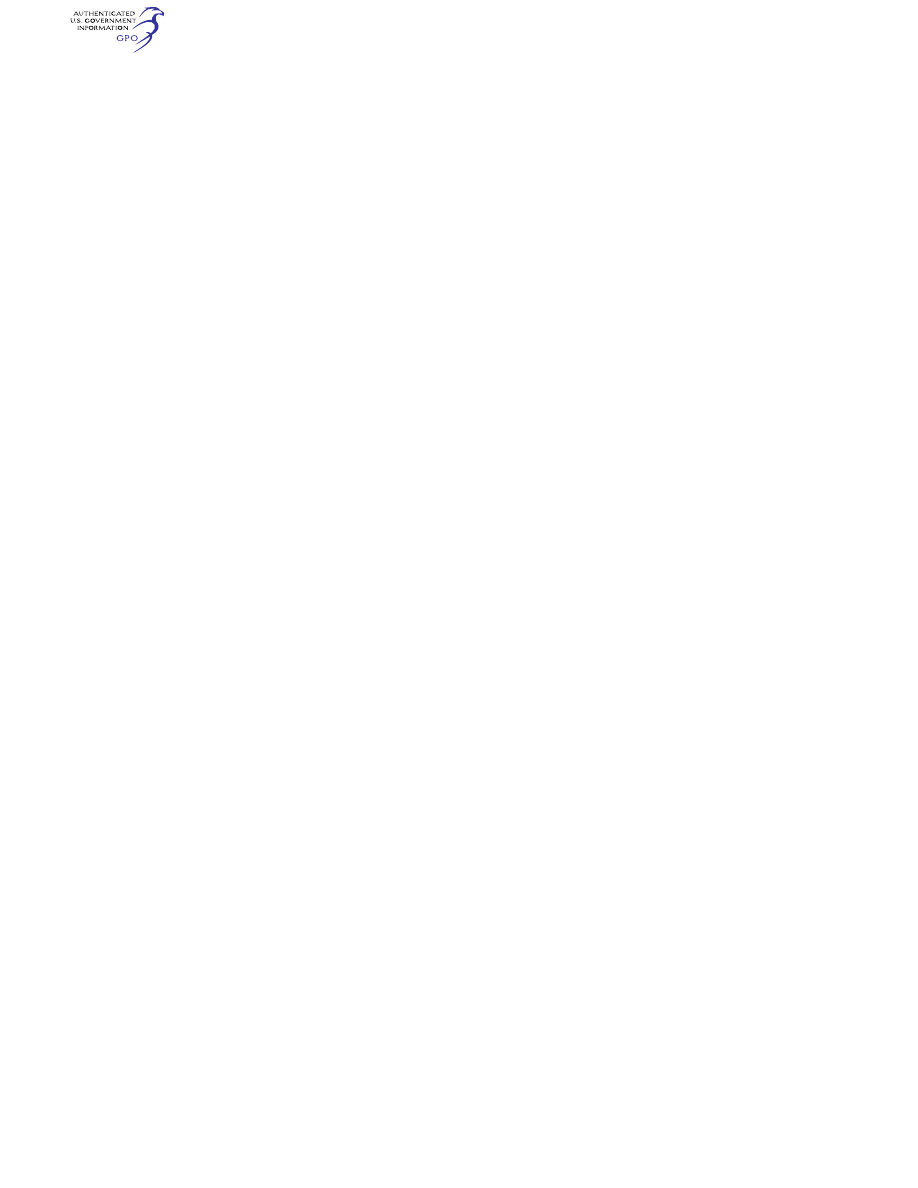
221
Federal Aviation Administration, DOT
§ 25.149
must have features to prevent inad-
vertent movement of the control
through the gated position. It must
only be possible to make this separate
and distinct motion once the control
has reached the gated position.
[Doc. No. 5066, 29 FR 18291, Dec. 24, 1964, as
amended by Amdt. 25–23, 35 FR 5671, Apr. 8,
1970; Amdt. 25–72, 55 FR 29774, July 20, 1990;
Amdt. 25–84, 60 FR 30749, June 9, 1995; Amdt.
25–98, 64 FR 6164, Feb. 8, 1999; 64 FR 10740,
Mar. 5, 1999; Amdt. 25–108, 67 FR 70827, Nov.
26, 2002]
§ 25.147
Directional and lateral con-
trol.
(a)
Directional control; general. It must
be possible, with the wings level, to
yaw into the operative engine and to
safely make a reasonably sudden
change in heading of up to 15 degrees in
the direction of the critical inoperative
engine. This must be shown at 1.3 V
S
R1
for heading changes up to 15 degrees
(except that the heading change at
which the rudder pedal force is 150
pounds need not be exceeded), and
with—
(1) The critical engine inoperative
and its propeller in the minimum drag
position;
(2) The power required for level flight
at 1.3
V
S
R1, but not more than max-
imum continuous power;
(3) The most unfavorable center of
gravity;
(4) Landing gear retracted;
(5) Flaps in the approach position;
and
(6) Maximum landing weight.
(b)
Directional control; airplanes with
four or more engines. Airplanes with
four or more engines must meet the re-
quirements of paragraph (a) of this sec-
tion except that—
(1) The two critical engines must be
inoperative with their propellers (if ap-
plicable) in the minimum drag posi-
tion;
(2) [Reserved]
(3) The flaps must be in the most fa-
vorable climb position.
(c)
Lateral control; general. It must be
possible to make 20
°
banked turns, with
and against the inoperative engine,
from steady flight at a speed equal to
1.3
V
S
R1, with—
(1) The critical engine inoperative
and its propeller (if applicable) in the
minimum drag position;
(2) The remaining engines at max-
imum continuous power;
(3) The most unfavorable center of
gravity;
(4) Landing gear (i) retracted and (ii)
extended;
(5) Flaps in the most favorable climb
position; and
(6) Maximum takeoff weight.
(d)
Lateral control; roll capability. With
the critical engine inoperative, roll re-
sponse must allow normal maneuvers.
Lateral control must be sufficient, at
the speeds likely to be used with one
engine inoperative, to provide a roll
rate necessary for safety without ex-
cessive control forces or travel.
(e)
Lateral control; airplanes with four
or more engines. Airplanes with four or
more engines must be able to make 20
°
banked turns, with and against the in-
operative engines, from steady flight at
a speed equal to 1.3
V
S
R1, with max-
imum continuous power, and with the
airplane in the configuration pre-
scribed by paragraph (b) of this section.
(f)
Lateral control; all engines oper-
ating. With the engines operating, roll
response must allow normal maneuvers
(such as recovery from upsets produced
by gusts and the initiation of evasive
maneuvers). There must be enough ex-
cess lateral control in sideslips (up to
sideslip angles that might be required
in normal operation), to allow a lim-
ited amount of maneuvering and to
correct for gusts. Lateral control must
be enough at any speed up to
V
FC
/
M
FC
to provide a peak roll rate necessary
for safety, without excessive control
forces or travel.
[Doc. No. 5066, 29 FR 18291, Dec. 24, 1964, as
amended by Amdt. 25–42, 43 FR 2321, Jan. 16,
1978; Amdt. 25–72, 55 FR 29774, July 20, 1990;
Amdt. 25–108, 67 FR 70827, Nov. 26, 2002;
Amdt. 25–115, 69 FR 40527, July 2, 2004]
§ 25.149
Minimum control speed.
(a) In establishing the minimum con-
trol speeds required by this section, the
method used to simulate critical en-
gine failure must represent the most
critical mode of powerplant failure
with respect to controllability ex-
pected in service.
(b) V
MC
is the calibrated airspeed at
which, when the critical engine is sud-
denly made inoperative, it is possible
to maintain control of the airplane
VerDate Sep<11>2014
09:06 Jun 28, 2024
Jkt 262046
PO 00000
Frm 00231
Fmt 8010
Sfmt 8010
Y:\SGML\262046.XXX
262046
jspears on DSK121TN23PROD with CFR

222
14 CFR Ch. I (1–1–24 Edition)
§ 25.149
with that engine still inoperative and
maintain straight flight with an angle
of bank of not more than 5 degrees.
(c)
V
MC
may not exceed 1.13
V
SR
with—
(1) Maximum available takeoff power
or thrust on the engines;
(2) The most unfavorable center of
gravity;
(3) The airplane trimmed for takeoff;
(4) The maximum sea level takeoff
weight (or any lesser weight necessary
to show
V
MC
);
(5) The airplane in the most critical
takeoff configuration existing along
the flight path after the airplane be-
comes airborne, except with the land-
ing gear retracted;
(6) The airplane airborne and the
ground effect negligible; and
(7) If applicable, the propeller of the
inoperative engine—
(i) Windmilling;
(ii) In the most probable position for
the specific design of the propeller con-
trol; or
(iii) Feathered, if the airplane has an
automatic feathering device acceptable
for showing compliance with the climb
requirements of § 25.121.
(d) The rudder forces required to
maintain control at
V
MC
may not ex-
ceed 150 pounds nor may it be nec-
essary to reduce power or thrust of the
operative engines. During recovery, the
airplane may not assume any dan-
gerous attitude or require exceptional
piloting skill, alertness, or strength to
prevent a heading change of more than
20 degrees.
(e) V
MCG
, the minimum control speed
on the ground, is the calibrated air-
speed during the takeoff run at which,
when the critical engine is suddenly
made inoperative, it is possible to
maintain control of the airplane using
the rudder control alone (without the
use of nosewheel steering), as limited
by 150 pounds of force, and the lateral
control to the extent of keeping the
wings level to enable the takeoff to be
safely continued using normal piloting
skill. In the determination of V
MCG
, as-
suming that the path of the airplane
accelerating with all engines operating
is along the centerline of the runway,
its path from the point at which the
critical engine is made inoperative to
the point at which recovery to a direc-
tion parallel to the centerline is com-
pleted may not deviate more than 30
feet laterally from the centerline at
any point. V
MCG
must be established
with—
(1) The airplane in each takeoff con-
figuration or, at the option of the ap-
plicant, in the most critical takeoff
configuration;
(2) Maximum available takeoff power
or thrust on the operating engines;
(3) The most unfavorable center of
gravity;
(4) The airplane trimmed for takeoff;
and
(5) The most unfavorable weight in
the range of takeoff weights.
(f) V
MCL
, the minimum control speed
during approach and landing with all
engines operating, is the calibrated air-
speed at which, when the critical en-
gine is suddenly made inoperative, it is
possible to maintain control of the air-
plane with that engine still inoper-
ative, and maintain straight flight
with an angle of bank of not more than
5 degrees. V
MCL
must be established
with—
(1) The airplane in the most critical
configuration (or, at the option of the
applicant, each configuration) for ap-
proach and landing with all engines op-
erating;
(2) The most unfavorable center of
gravity;
(3) The airplane trimmed for ap-
proach with all engines operating;
(4) The most favorable weight, or, at
the option of the applicant, as a func-
tion of weight;
(5) For propeller airplanes, the pro-
peller of the inoperative engine in the
position it achieves without pilot ac-
tion, assuming the engine fails while at
the power or thrust necessary to main-
tain a three degree approach path
angle; and
(6) Go-around power or thrust setting
on the operating engine(s).
(g) For airplanes with three or more
engines, V
MCL-2
, the minimum control
speed during approach and landing
with one critical engine inoperative, is
the calibrated airspeed at which, when
a second critical engine is suddenly
made inoperative, it is possible to
maintain control of the airplane with
both engines still inoperative, and
maintain straight flight with an angle
VerDate Sep<11>2014
09:06 Jun 28, 2024
Jkt 262046
PO 00000
Frm 00232
Fmt 8010
Sfmt 8010
Y:\SGML\262046.XXX
262046
jspears on DSK121TN23PROD with CFR

223
Federal Aviation Administration, DOT
§ 25.161
of bank of not more than 5 degrees.
V
MCL-2
must be established with—
(1) The airplane in the most critical
configuration (or, at the option of the
applicant, each configuration) for ap-
proach and landing with one critical
engine inoperative;
(2) The most unfavorable center of
gravity;
(3) The airplane trimmed for ap-
proach with one critical engine inoper-
ative;
(4) The most unfavorable weight, or,
at the option of the applicant, as a
function of weight;
(5) For propeller airplanes, the pro-
peller of the more critical inoperative
engine in the position it achieves with-
out pilot action, assuming the engine
fails while at the power or thrust nec-
essary to maintain a three degree ap-
proach path angle, and the propeller of
the other inoperative engine feathered;
(6) The power or thrust on the oper-
ating engine(s) necessary to maintain
an approach path angle of three de-
grees when one critical engine is inop-
erative; and
(7) The power or thrust on the oper-
ating engine(s) rapidly changed, imme-
diately after the second critical engine
is made inoperative, from the power or
thrust prescribed in paragraph (g)(6) of
this section to—
(i) Minimum power or thrust; and
(ii) Go-around power or thrust set-
ting.
(h) In demonstrations of V
MCL
and
V
MCL-2
—
(1) The rudder force may not exceed
150 pounds;
(2) The airplane may not exhibit haz-
ardous flight characteristics or require
exceptional piloting skill, alertness, or
strength;
(3) Lateral control must be sufficient
to roll the airplane, from an initial
condition of steady flight, through an
angle of 20 degrees in the direction nec-
essary to initiate a turn away from the
inoperative engine(s), in not more than
5 seconds; and
(4) For propeller airplanes, hazardous
flight characteristics must not be ex-
hibited due to any propeller position
achieved when the engine fails or dur-
ing any likely subsequent movements
of the engine or propeller controls.
[Doc. No. 5066, 29 FR 18291, Dec. 24, 1964, as
amended by Amdt. 25–42, 43 FR 2321, Jan. 16,
1978; Amdt. 25–72, 55 FR 29774, July 20, 1990; 55
FR 37607, Sept. 12, 1990; Amdt. 25–84, 60 FR
30749, June 9, 1995; Amdt. 25–108, 67 FR 70827,
Nov. 26, 2002]
T
RIM
§ 25.161
Trim.
(a)
General. Each airplane must meet
the trim requirements of this section
after being trimmed, and without fur-
ther pressure upon, or movement of, ei-
ther the primary controls or their cor-
responding trim controls by the pilot
or the automatic pilot.
(b)
Lateral and directional trim. The
airplane must maintain lateral and di-
rectional trim with the most adverse
lateral displacement of the center of
gravity within the relevant operating
limitations, during normally expected
conditions of operation (including op-
eration at any speed from 1.3
V
SR1
to
V
MO
/M
MO
).
(c)
Longitudinal trim. The airplane
must maintain longitudinal trim dur-
ing—
(1) A climb with maximum contin-
uous power at a speed not more than
1.3
V
SR1
, with the landing gear re-
tracted, and the flaps (i) retracted and
(ii) in the takeoff position;
(2) Either a glide with power off at a
speed not more than 1.3 V
SR1
, or an ap-
proach within the normal range of ap-
proach speeds appropriate to the
weight and configuration with power
settings corresponding to a 3 degree
glidepath, whichever is the most se-
vere, with the landing gear extended,
the wing flaps (i) retracted and (ii) ex-
tended, and with the most unfavorable
combination of center of gravity posi-
tion and weight approved for landing;
and
(3) Level flight at any speed from 1.3
V
SR1
, to
V
MO
/M
MO,
with the landing gear
and flaps retracted, and from 1.3
V
SR1
to
V
LE
with the landing gear extended.
(d)
Longitudinal, directional, and lat-
eral trim. The airplane must maintain
longitudinal, directional, and lateral
trim (and for the lateral trim, the
VerDate Sep<11>2014
09:06 Jun 28, 2024
Jkt 262046
PO 00000
Frm 00233
Fmt 8010
Sfmt 8010
Y:\SGML\262046.XXX
262046
jspears on DSK121TN23PROD with CFR


